Five groups have stood out in InSight Crime’s coverage during 2023. We analyze why, and what they tell us about criminal developments in Latin America and the Caribbean over the year.
Over the past decade, InSight Crime has developed a complex methodology to map, measure, and analyze the characteristics of criminal groups with an established territorial presence. Our experts use information obtained through fieldwork, interviews, and databases to measure the following variables: territorial reach (40 points), criminal economies (40 points), state penetration (40 points), military capacity (40 points), structure (40 points), leadership (20 points), and criminal alliances (10 points).
We applied this criminal index methodology to the five most frequently mentioned groups in our coverage in 2023 and these were the results.
5. MS13
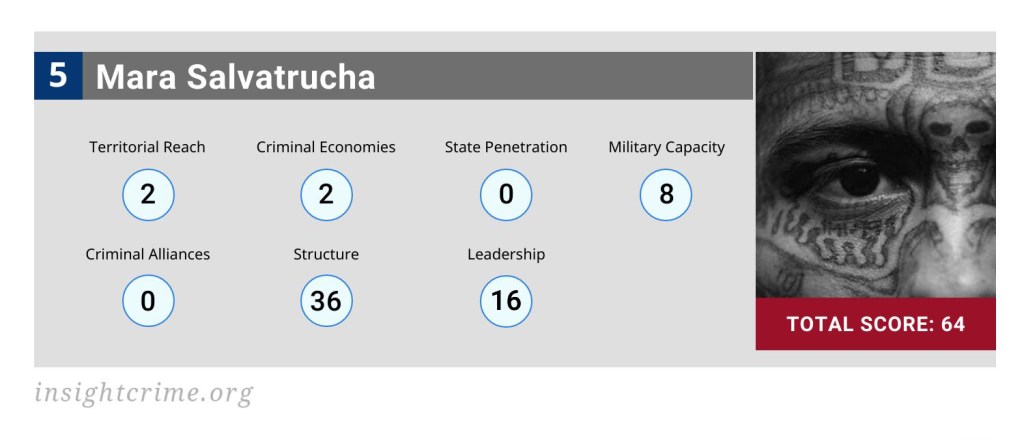
Mara Salvatrucha, or MS13, the most notorious street gang in Central America, has been one of the main topics of InSight Crime’s coverage in 2023, not because its power is growing, but because it has been the target of relentless security force operations and a policy of mass incarceration.
Although the gang has a presence in Honduras and Guatemala, its home base is El Salvador, where MS13 has been the target of President Nayib Bukele’s mano dura, or “iron fist” policy, which began in 2022.
SEE ALSO: El Salvador’s (Perpetual) State of Emergency: How Bukele’s Government Overpowered Gangs
As a result, the MS13 has been severely weakened in El Salvador, with just 33% of its members still at large, according to figures from the National Civil Police. According to InSight Crime’s investigations, the remaining MS13 cells have lost much of their ability to control territory. While it is possible that some of its members still engage in extortion or petty crime, this appears to occur sporadically.
According to our metrics, the MS13 currently has a score of 64 out of a possible 230 points, making it the weakest of the top 5 criminal newsmakers in 2023.
The question is whether the weakening of the MS13 will be long-lasting or whether it will be able to adapt to the current offensive by the security forces. History shows that the more gang members that enter the prisons, the stronger the gang becomes in the long run. Will Bukele be able to break the cycle permanently?
4. The Choneros and Lobos in Ecuador
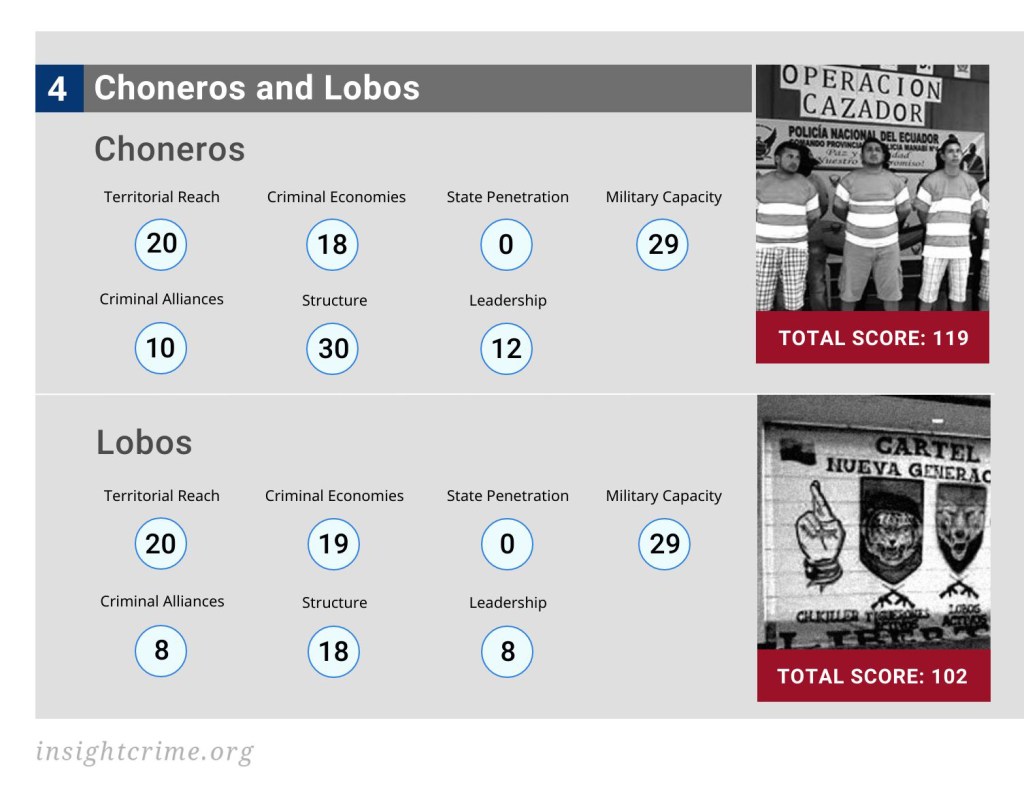
Relative newcomers to the transnational criminal scene, the Choneros received international attention following the assassination of presidential candidate Fernando Villavicencio in August 2023. His murder revealed criminal dynamics that have evolved exponentially over the past four years, plunging the country into unprecedented levels of violence.
For years, the Choneros gang was the dominant criminal structure in Ecuador, working as a subcontractor for international groups from Colombia, Mexico, and Europe to secure cocaine shipments. However, the fragmentation of the group gave rise to its main rival, the Lobos, who now dispute its power and seek their share of the criminal pie.
Although different, both groups received similar scores in InSight Crime’s index: 119 for the Choneros and 102 for the Lobos. Their prominence in our coverage is due to their accelerated criminal development and the violence that has accompanied it, fueled by drug trafficking.
The country went from registering six homicides per 100,000 inhabitants in 2016 to 25 per 100,000 in 2022. This increase aligns geographically with the main cocaine corridors in Ecuador, a transit country on the drug route. One of the routes runs through the Pacific province of Esmeraldas, which was the country’s most violent last year.
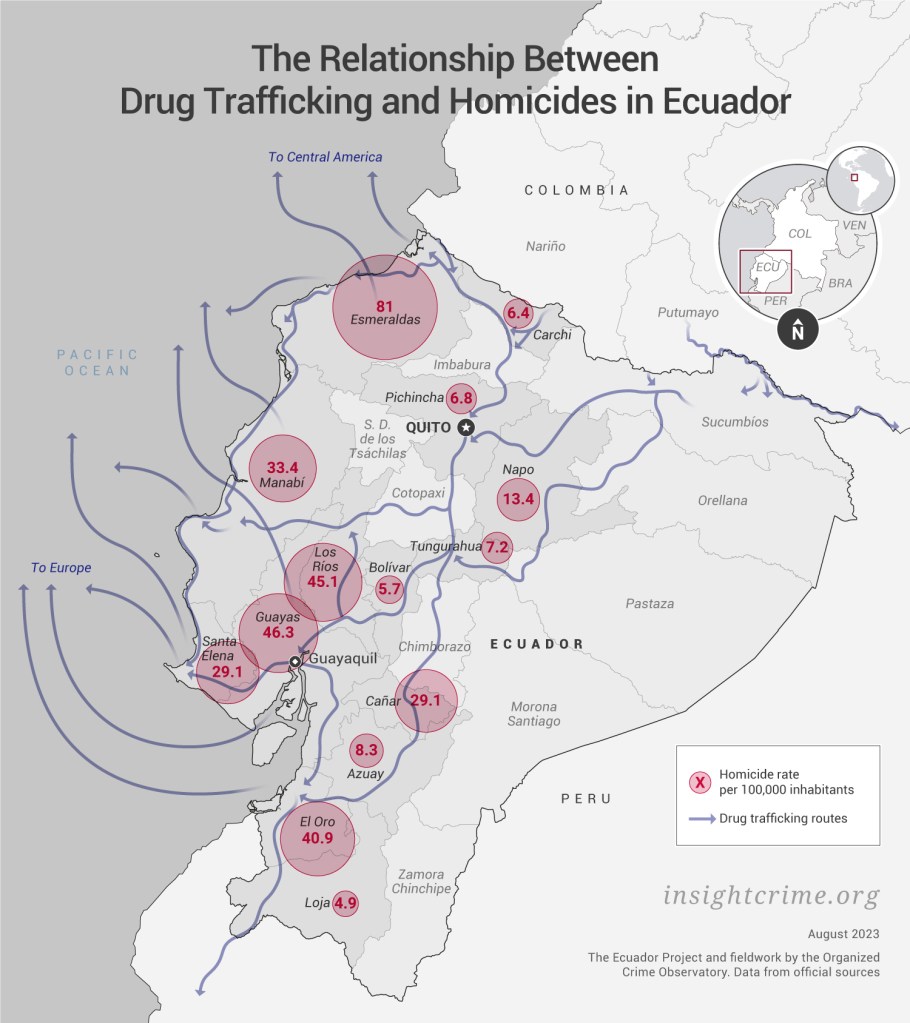
Another hotspot of violence is Guayaquil, in Guayas province, the country’s busiest port from where cocaine is shipped to international markets, mainly Europe and North America. Homicides there rose from 293 in 2016 to 2,033 in 2022.
The dispute between the Choneros and the Lobos over these trafficking routes has fed the increase in homicides.
3. Tren de Aragua
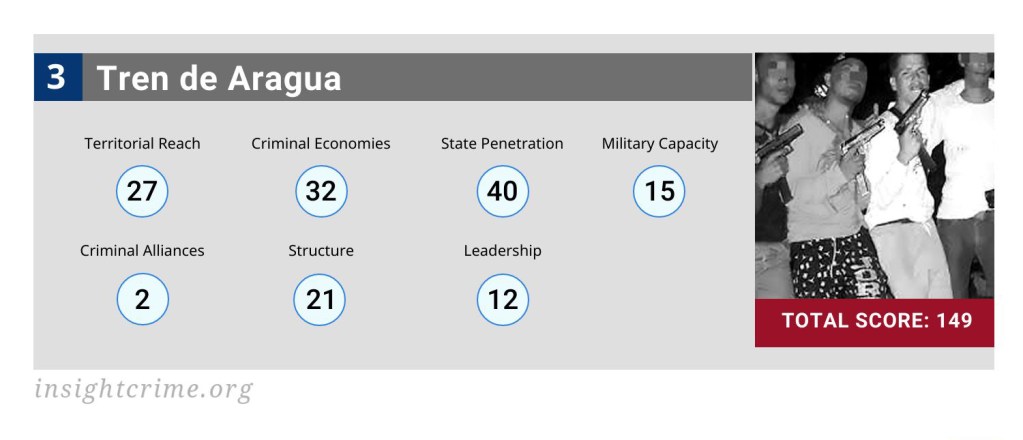
The Tren de Aragua (TdA), a prison gang in Venezuela, has established itself as one of the most feared criminal structures in South America during 2023, and registered a score of 149 in our index. The Tren de Aragua brand is now so powerful that unaffiliated criminal groups in Colombia, Peru, and Chile are adopting its name to commit crimes.
Tren de Aragua lost its base of operations, the Tocorón prison in Aragua state, in September 2023, after 11,000 police and soldiers took control of the penitentiary. The result was the eviction of the gang from its stronghold, but its top leaders, including Hector Rusthenford Guerrero Flores, alias “Niño Guerrero,” escaped before the operation was launched, clearly warned well in advance.
The loss of Tocorón not only meant the dismantling of a base of operations for the Tren de Aragua, but also the loss of the protection and near total impunity that allowed Niño Guerrero and his accomplices to build and run a criminal empire that stretched far beyond the prison gates across South America. With the authorities’ takeover of the prison, Tren de Aragua lost revenue from various criminal activities inside the jail, including extortion of inmates, drug dealing, and contraband smuggling.
Tren de Aragua is unusual in that it went transnational not through drug trafficking, but off the backs of the millions of Venezuelan migrants that have fanned out across South America since 2015, exploiting them at every step. However, the group has managed to establish involvement in at least 12 illicit economies in five countries in the region, which could allow the gang to maintain its criminal operations despite the loss of Tocorón.

2. Sinaloa Cartel
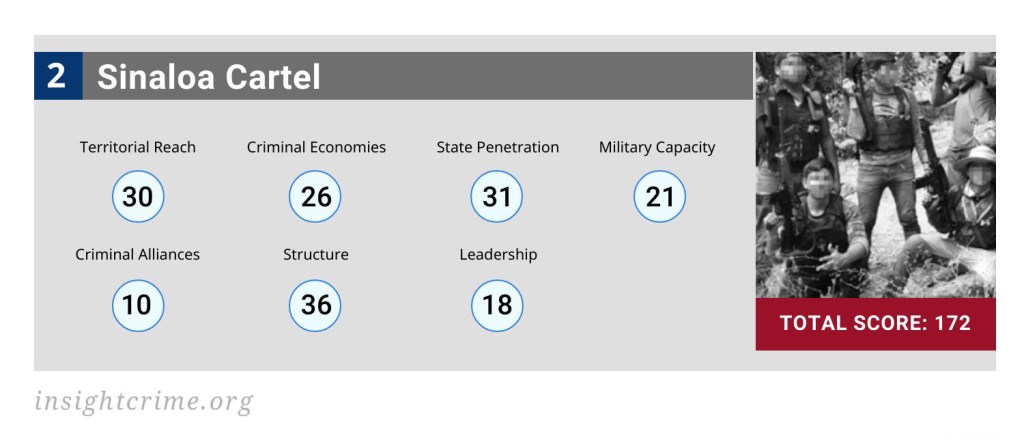
The Sinaloa Cartel dominated InSight Crime’s coverage of Mexico in 2023, and despite ruptures within the group, it scored 172 on our criminal index. The group consolidated its position as one of the main traffickers of fentanyl from Mexico. Although the Chapitos faction banned fentanyl production and trafficking in Sinaloa, the flow of the drug appeared to double over the year.

The extent to which the fentanyl ban is being enforced remains unclear, but it appears to have extended to some elements of the Sinaloa Cartel in Sonora. There, factions of the cartel have engaged in a wave of violence over control of migrant routes, evidence that the group intends to tighten control over other lucrative criminal economies, while waiting for government pressure on fentanyl to ease.
The internal disputes come on top of the extradition of Ovidio Guzmán López, an important leader of the Chapitos, one of the cartel’s pillars. This is the second major extradition after that of its top leader and Ovidio’s father, Joaquín Guzmán Loera, alias “El Chapo,” in 2017. While this weakened the Sinaloa Cartel, it remains one of the most important drug trafficking organizations in Latin America and the Caribbean, along with the Jalisco Cartel New Generation (Cartel Jalisco Nueva Generación – CJNG).
The US government blames the Sinaloa Cartel for the runaway rise in overdose deaths attributed to this synthetic opioid. In 2022, data from the Centers for Disease Control and Prevention (CDC) revealed that opioids, primarily illicit fentanyl, contributed to nearly three-quarters of the approximately 110,000 overdose deaths recorded nationwide.
1. ELN
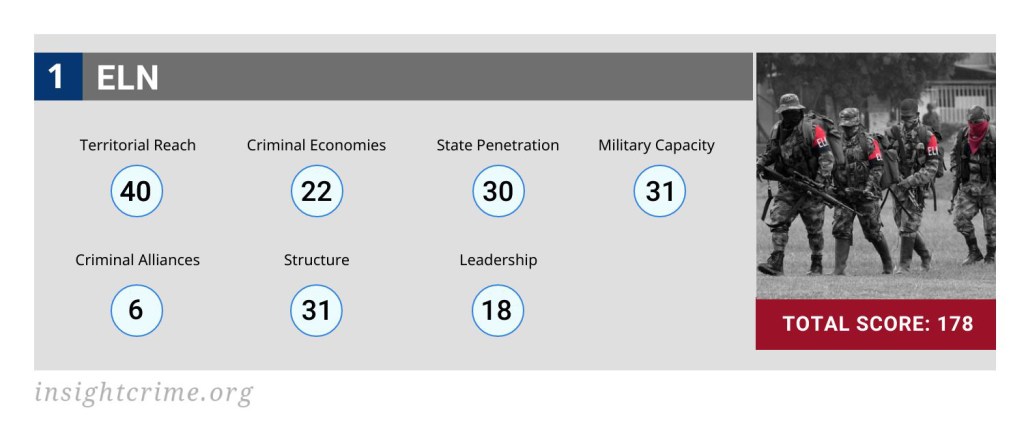
Although Colombia has a complex and diverse criminal landscape, the guerrillas of the National Liberation Army (Ejército de Liberación Nacional – ELN) dominated our 2023 coverage of the country, growing in strength and attaining an index score of 178 out of a possible 230. The ELN also has an extensive presence in Venezuela, where it enjoys protection from the regime of Nicolás Maduro, contributing to its high index score.
The country’s other two most powerful groups, the Gaitanista Self-Defense Forces of Colombia (Autodefensas Gaitanistas de Colombia – AGC) and the Central General Staff (Estado Mayor Central – EMC), scored 170 and 128 respectively. ELN coverage and activity during 2023 was shaped by turbulent negotiations with the Colombian government, within the framework of President Gustavo Petro’s “Total Peace” policy, which aims to bring an end to Colombia’s six-decade-old civil conflict.
A ceasefire negotiated with the Colombian government, and protection within Venezuela, mean that the ELN have escaped sustained security force pressure, although the rebels have been in endless conflict with their rivals, the Gaitanistas and ex-FARC EMC, feeding violence across much of Colombia.
But despite ongoing negotiations, the guerrillas continue to grow stronger through recruitment, kidnappings, and drug trafficking, especially along the Colombian-Venezuelan border.
The ELN is in the process of establishing hegemonic power along this frontier. With a presence in 19 of the 20 Venezuelan municipalities bordering Colombia, it controls more frontier crossing points, drug production zones, and smuggling routes than the Venezuelan state.
Conclusions From the Criminal Index Measurements for 2023
The placement of Ecuadorian groups in the top 5 reflects the explosive growth of native organized crime in that country, where previously Colombian groups played a dominant role. The assassination of a presidential candidate and the subsequent murder in prison of the men arrested in connection with the crime, reveals the extraordinary reach of Ecuadorian organized crime now, and its lack of fear of the security forces. Ecuador is now one of the principal transit nations in South America for cocaine, and this is likely to feed yet more criminal evolution and violence.
The rest of our top five are well established criminal groups, two of which have been battered during 2023. The MS13 suffered significant weakening due to the Bukele offensive and mass incarcerations, while the Tren de Aragua will have to pivot from a prison gang to a transnational federation or franchise if it is to continue its evolution.
Drug trafficking remains the most stable element of many gangs’ criminal portfolios, with cocaine, marijuana, and synthetic drugs all seeing increased production over 2023. But migration is also a major source of income for Latin American organized crime, with almost 8 million Venezuelans having left their country since 2015, and more recent waves of migrants from Haiti and Ecuador now joining the steady flow from the Northern Triangle nations (El Salvador, Guatemala, and Honduras), most heading to the United States.

